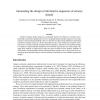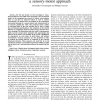710 search results - page 4 / 142 » Adaptation to Sensory Delays |
ARVLSI
1999
IEEE
13 years 11 months ago
1999
IEEE
The ability of animals to select a limited region of sensory space for scrutiny is an important factor in dealing with cluttered or complex sensory environments. Such an attention...
JCNS
2011
13 years 2 months ago
2011
Adaptive stimulus design methods can potentially improve the efficiency of sensory neurophysiology experiments significantly; however, designing optimal stimulus sequences in re...
TSMC
2010
13 years 2 months ago
2010
Abstract--For the last decade, we have developed a visionbased architecture for mobile robot navigation. Our bio-inspired model of the navigation has proved to achieve sensory-moto...
BC
1999
13 years 7 months ago
1999
A model is presented to study and quantify the contribution of all available sensory information to human standing based on optimal estimation theory. In the model, delayed sensory...
IJON
2000
13 years 7 months ago
2000
Time delays are ubiquitous in the nervous system. Empirical "ndings suggest that time delays are adapted when considering the synchronous activity of neurons. We introduce a ...


